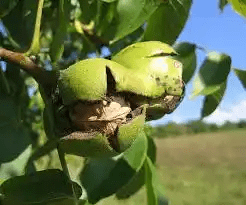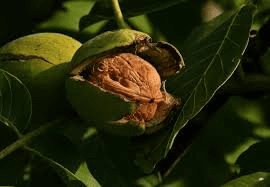Juglans regia, commonly known as the Persian or English walnut, is a deciduous tree prized for its delicious and nutritious nuts. It’s native to the region spanning from the Balkans to the Himalayas but has been widely cultivated around the world for its culinary and commercial value.
The tree itself is sizable, reaching heights of 30–130 feet, with a broad canopy. It bears compound leaves consisting of several leaflets and produces fruits known as walnuts or walnuts in shells.
The nuts have a hard shell that encases the edible seed or kernel, which is rich in omega-3 fatty acids, antioxidants, vitamins (particularly vitamin E), and minerals (such as manganese, copper, and magnesium).
Walnuts are a versatile food item, enjoyed raw or roasted, eaten on their own, or used in various culinary preparations like salads, baked goods, desserts, and savory dishes. Their distinct earthy flavor and crunchy texture make them a popular addition to many recipes.
Aside from their culinary appeal, walnuts are known for their potential health benefits. They’re believed to support heart health, brain function, and overall well-being due to their high content of healthy fats and antioxidants.
Consuming walnuts in moderation is associated with lower cholesterol levels, improved cognition, and reduced inflammation.
The wood of the walnut tree is highly prized for its beauty and strength, often used in high-quality furniture making, cabinetry, and woodworking due to its attractive grain and durability.
Culturally, walnuts have historical significance and are associated with various traditions and beliefs in different parts of the world.
The Botanical Description of Walnut
1. Shape and Size: Walnut trees typically reach heights of 30 to 130 feet, forming a broadly rounded, majestic canopy.
2. Leaves: Pinnately compound, walnut leaves consist of 5 to 25 lanceolate leaflets with a finely serrated edge.
3. Bark: Smooth and light gray when young, walnut tree bark gradually develops deep furrows and darkens as the tree matures.
4. Flowers: Walnut trees produce inconspicuous male and female flowers. Male flowers are in catkins, while female flowers are small and appear in clusters.
5. Fruit: The walnut’s fruit is a large, single-seeded drupe enclosed in a green, fleshy husk.
6. Root System: Walnut trees have a deep taproot and a widespread lateral root system.
7. Reproduction: Walnuts reproduce through both sexual and asexual means, producing seeds while grafting and budding are common methods for propagation.
8. Growing Conditions: Thriving in well-drained soil with good sunlight exposure, walnuts are hardy and adaptable to various climates.
9. Growth Rate: Moderately paced, walnut trees may take several years to reach maturity and produce significant yields.
10. Longevity: Known for longevity, some walnut specimens can live for several hundred years under optimal conditions.
The Geographic Distribution of Walnut
1. Native Regions: Walnut trees are native to regions of Eurasia, including parts of southeast Europe, southwest Asia, and the Himalayas.
2. North America Introduction: Introduced to North America by European settlers, walnuts now thrive in various parts of the United States and Canada.
3. Cultivation in Asia: Asia, particularly China, Iran, and Turkey, is a major hub for walnut cultivation, with diverse varieties adapted to different climates.
4. European Presence: Walnut trees are also found in parts of southern Europe, where they have been cultivated for centuries.
5. Ideal Climate: Walnuts prefer temperate climates with distinct seasons, although certain varieties can adapt to subtropical conditions.
6. Altitude Range: Walnuts can be found at varying altitudes, from lowland areas to mountainous regions.
7. Soil Preferences: They grow well in a range of soils, but a preference for well-drained, loamy soil is notable.
8. Environmental Impact: The presence of walnut trees contributes to biodiversity, providing habitats for various species.
9. Human Cultivation: Human cultivation has expanded the natural range of walnuts, with orchards established in regions favorable to their growth.
The Chemical Composition of Walnut
1. Fatty Acids: Rich in omega-3 and omega-6 fatty acids, walnuts promote heart health and reduce inflammation.
2. Antioxidants: Polyphenols, tocopherols, and melatonin are antioxidants found in walnuts, offering protection against oxidative stress.
3. Proteins: Walnuts provide plant-based proteins, essential for various bodily functions and muscle development.
4. Vitamins: Containing B vitamins, vitamin E, and vitamin K, walnuts contribute to overall health.
5. Minerals: A good source of minerals like magnesium, phosphorus, and copper, walnuts support bone health and enzyme function.
6. Fiber: Rich in dietary fiber, walnuts aid digestion and help maintain a healthy gut.
7. Phytosterols: Walnuts contain phytosterols that help lower cholesterol levels, benefiting cardiovascular health.
8. Carbohydrates: While low in carbohydrates, walnuts provide a sustainable energy source.
9. Phytochemicals: Phytochemicals like quinone juglone exhibit antimicrobial properties in walnuts.
10. Water Content: With moderate water content, walnuts contribute to hydration and nutrient absorption.
11. Carotenoids: Walnuts contain carotenoids, which have antioxidant and anti-inflammatory properties.
12. Tannins: Tannins in walnuts contribute to their astringent taste and may have antioxidant benefits.
Read Also: How to Grow and Care for Alaska Pollock
The Medicinal Health Benefits Of Walnut (Juglans regia)

1. Cardiovascular Health: Walnuts promote heart health by reducing LDL cholesterol levels and improving overall cardiovascular function.
2. Brain Function: Omega-3 fatty acids in walnuts support cognitive function and may help prevent age-related cognitive decline.
3. Anti-Inflammatory Properties: Polyphenols and antioxidants in walnuts contribute to their anti-inflammatory effects, reducing the risk of chronic diseases.
4. Weight Management: Despite their calorie density, walnuts may aid in weight management by promoting a feeling of fullness and supporting metabolism.
5. Diabetes Management: Walnuts may help manage blood sugar levels, making them beneficial for individuals with diabetes.
6. Cancer Prevention: Antioxidants in walnuts, including ellagic acid, may have cancer-preventive properties.
7. Improved Sleep: Melatonin in walnuts contributes to better sleep quality and regulation of the sleep-wake cycle.
8. Skin Health: Vitamins and antioxidants in walnuts contribute to healthier skin by reducing oxidative stress.
9. Hair Benefits: The presence of biotin and omega-3 fatty acids supports hair health and may prevent hair loss.
10. Immune System Support: Nutrients in walnuts, including zinc and vitamin C, support a healthy immune system.
11. Digestive Health: The fiber content in walnuts promotes digestive regularity and gut health.
12. Bone Health: Minerals like phosphorus and magnesium in walnuts contribute to bone strength and density.
13. Anti-Aging Properties: The combination of antioxidants and nutrients in walnuts may have anti-aging effects on the skin and body.
14. Hormonal Balance: Walnuts may help balance hormones, benefiting reproductive and overall hormonal health.
15. Liver Health: Certain compounds in walnuts may support liver function and detoxification processes.
16. Respiratory Health: The anti-inflammatory properties of walnuts may benefit respiratory health.
17. Stress Reduction: Walnuts contain compounds that may help reduce stress and promote a sense of well-being.
The Methods of Usage to Achieve the Provided Health Benefits Of Walnut (Juglans regia)
1. Raw Consumption: Consuming a handful of raw walnuts daily is a simple way to harness their nutritional benefits.
2. Walnut Oil: Walnut oil, extracted from the nuts, is used in cooking and salads to retain the health benefits.
3. Culinary Additions: Chop walnuts and sprinkle them on salads, yogurt, or oatmeal for a crunchy texture and enhanced nutrition.
4. Nut Butter: Prepare walnut butter by blending roasted walnuts until smooth. Use it as a spread or in recipes for a rich, nutty flavor.
5. Baking Ingredient: Incorporate chopped walnuts into baking recipes such as muffins, cookies, and bread for added taste and a nutrient boost.
6. Trail Mix: Create a nutritious trail mix by combining walnuts with dried fruits, seeds, and dark chocolate for a satisfying and energy-boosting snack.
7. Smoothies: Add a handful of walnuts to your favorite smoothie for a creamy texture and an infusion of essential nutrients.
8. Infused Water: Soak walnuts in water overnight and consume the infused water in the morning for a refreshing and health-promoting drink.
9. Tea Infusion: Make a walnut tea infusion by steeping crushed walnut leaves in hot water, providing a mild and soothing beverage.
10. Salad Topper: Sprinkle crushed walnuts on salads to enhance both flavor and nutritional content, making salads more satisfying.
The Side Effects Of Using Walnut Medicinal Plant
1. Allergic Reactions: Some individuals may experience allergic reactions to walnuts, leading to symptoms like itching, swelling, or difficulty breathing.
2. Digestive Issues: Consuming excessive amounts of walnuts may cause digestive issues such as bloating, gas, or diarrhea in sensitive individuals.
3. Caloric Density: While nutrient-rich, walnuts are calorie-dense, and overconsumption may contribute to weight gain if not monitored.
4. Oxalate Content: Walnuts contain oxalates, and individuals prone to kidney stones may need to moderate their walnut intake.
5. Anticoagulant Effects: Due to omega-3 fatty acids, excessive walnut consumption may have anticoagulant effects, affecting blood clotting.
6. Aflatoxin Concerns: Walnuts may be susceptible to aflatoxin contamination, a potential health risk if not stored properly.
7. Interactions with Medications: Individuals on blood-thinning medications should exercise caution, as walnuts may interact and enhance the medication’s effects.
8. Impact on Blood Sugar: While generally beneficial for diabetes management, individuals should monitor blood sugar levels as part of a balanced diet.
9. Tannin Sensitivity: Some people may be sensitive to tannins in walnuts, experiencing astringency or mild irritation.
10. Fungal Infections: Improper storage of walnuts may lead to fungal growth, posing a risk of infections if consumed unknowingly.
11. Nutrient Imbalance: Excessive reliance on walnuts alone may lead to a nutrient imbalance. A varied diet is crucial for overall health.
12. Medicinal Interactions: Individuals taking medications for specific health conditions should consult with a healthcare professional before incorporating walnuts into their diet.
Read Also: Which Herbs and Spices are good for you (cinnamon, paprika, etc)
The Scientific Research and Studies of Walnut

1. Cardiovascular Studies: Research indicates that regular walnut consumption is associated with improved cardiovascular health, including reduced cholesterol levels.
2. Cognitive Function: Studies suggest that the omega-3 fatty acids in walnuts may positively impact cognitive function and reduce the risk of neurodegenerative diseases.
3. Anti-Inflammatory Effects: Scientific investigations reveal that polyphenols and antioxidants in walnuts contribute to anti-inflammatory effects, potentially preventing chronic diseases.
4. Weight Management Trials: Clinical trials suggest that despite their calorie density, incorporating walnuts into a balanced diet may aid in weight management.
5. Diabetes and Blood Sugar Control: Research points to the potential benefits of walnuts in managing blood sugar levels, making them suitable for individuals with diabetes.
6. Cancer Prevention Research: Studies explore the role of walnut antioxidants, such as ellagic acid, in preventing certain types of cancer.
7. Sleep Regulation: Scientific studies highlight the melatonin content in walnuts, linking it to improved sleep quality and regulation of circadian rhythms.
8. Skin and Hair Studies: Research indicates that the vitamins and antioxidants in walnuts contribute to healthier skin and hair.
9. Immune System Support: Scientific investigations suggest that nutrients in walnuts, including zinc and vitamin C, contribute to a robust immune system.
10. Anti-Aging Effects: Studies explore the potential anti-aging effects of the combination of antioxidants and nutrients found in walnuts.
The Safety Precautions and Recommendations In Using Walnut Medicinal Plant
1. Allergy Testing: Individuals with nut allergies should conduct allergy tests before incorporating walnuts into their diet.
2. Portion Control: Exercise portion control due to the calorie density of walnuts to avoid unintended weight gain.
3. Proper Storage: Store walnuts in a cool, dry place to prevent aflatoxin contamination and ensure their safety.
4. Balanced Diet: Include walnuts as part of a balanced diet rather than relying solely on them to avoid nutrient imbalances.
5. Consultation with Healthcare Professionals: Individuals with specific health conditions or those taking medications should consult healthcare professionals before adding walnuts to their routine.
6. Monitoring Blood Sugar: Individuals with diabetes should monitor blood sugar levels when incorporating walnuts into their diet as part of a comprehensive management plan.
7. Kidney Stone Concerns: Individuals prone to kidney stones should moderate walnut intake due to the oxalate content.
8. Blood Clotting Precautions: Those on blood-thinning medications should use walnuts cautiously, as they may enhance the anticoagulant effects.
9. Varied Consumption: Diversify walnut consumption methods to avoid potential side effects associated with excessive raw or processed intake.
10. Children and Nut Allergies: Exercise caution when introducing walnuts to children, especially those with known nut allergies.
11. Fungal Infection Awareness: Be vigilant about proper walnut storage to prevent fungal infections, especially in humid environments.
12. Pregnancy and Lactation: Pregnant and lactating individuals should seek guidance from healthcare professionals regarding walnut consumption for optimal health.
FAQs About Walnut Medicinal Plant
1. Are Walnuts Safe for Individuals with Nut Allergies?
Yes, it’s crucial to conduct allergy tests before consuming walnuts, especially for individuals with known nut allergies.
2. How Many Walnuts Should I Consume Daily for Health Benefits?
A handful of walnuts (about 1 ounce or 28 grams) per day is a recommended serving for health benefits.
3. Can Walnuts Help Lower Cholesterol Levels?
Yes, scientific studies suggest that regular walnut consumption may contribute to lower cholesterol levels.
4. Are There Any Precautions for Pregnant Women Regarding Walnut Consumption?
Pregnant women should consult healthcare professionals for personalized advice on walnut consumption during pregnancy.
5. Can Walnuts Be Included in a Child’s Diet?
Walnuts can be introduced to a child’s diet, but parents should be cautious, especially if there is a family history of nut allergies.
6. How Should Walnuts Be Stored to Prevent Contamination?
Store walnuts in a cool, dry place to prevent aflatoxin contamination, and avoid humid environments.
7. Can Walnuts Help Manage Blood Sugar Levels?
Research suggests that walnuts may have benefits in managing blood sugar levels, making them suitable for individuals with diabetes.
8. Are There Any Medicinal Interactions with Walnut Consumption?
Individuals taking specific medications should consult healthcare professionals to ensure there are no interactions with walnut consumption.
9. Can Walnuts Be Beneficial for Skin Health?
Yes, the vitamins and antioxidants in walnuts may contribute to healthier skin when consumed as part of a balanced diet.
Read Also: How to Grow Tomatoes in Containers

